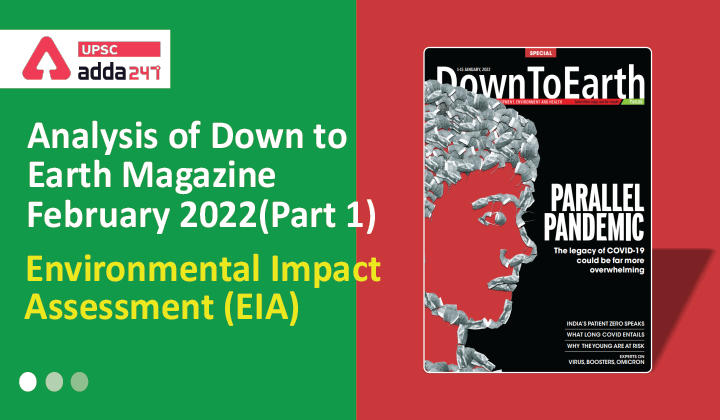Table of Contents
Environmental Impact Assessment (EIA)
Relevance
”GS 3: Environmental Impact Assessment (EIA)”
Introduction
- A signatory to the Stockholm Declaration (1972) on Environment, India enacted laws to control water (1974) and air (1981) pollution soon after. But it was only after the Bhopal gas leak disaster in 1984 that the country legislated an umbrella Act for environmental protection in 1986.
- Under the Environment (Protection) Act, 1986, India notified its first EIA norms in 1994, setting in place a legal framework for regulating activities that access, utilise, and affect (pollute) natural resources. Every development project has been required to go through the EIA process for obtaining prior environmental clearance ever since.
- The 1994 EIA notification was replaced with a modified draft in 2006. Earlier this year, the government redrafted it again to incorporate the amendments and relevant court orders issued since 2006, and to make the EIA “process more transparent and expedient.”
What is the necessity of an EIA Notification?
- An EIA notification is issued under Section 3 of the Environment Protection Act, 1986, to impose restrictions on setting up new projects or expansion or modernisation of existing projects.
- The section stipulates that such measures must benefit the environment.
- In the April 1, 2020 order, the Supreme Court also said: “For an action of the Central government to be treated as a measure referable to Section 3, it must satisfy the statutory requirement of being necessary or expedient for the purpose of protecting and improving the quality of the environment and preventing, controlling and abating environment pollution”.
What is the Current Controversy?
- Recently the Union Ministry of Environment, Forest and Climate Change (moefcc) said that it will rank the state environmental impact assessment authorities based on the speed at which environmental approvals are given.
- It has been decided to incentivise the states through a star-rating system, based on efficiency and timelines in grant of EC (environmental clearance).
- This is intended as a mode of recognition and encouragement as well as for prompting improvements.
States clear bulk of projects
- State authorities carry out the bulk of the Environmental Impact Assessments for proposed projects.
- While major ‘Category A’ projects like highways are cleared by the Centre, the rest, including mining, thermal plants, river valley and infra projects, fall under the purview of state bodies, except in case of huge projects.
Categories of Projects?
- A maze of categories— projects falling into A, B, BI and B2—were created, with overlaps and a good measure of discretion thrown in. All in all the quality of scrutiny has not improved and development projects are not more environmentally compliant.
- Category A projects come to the Centre and B go to the state, where the state authority then decides if it is B1 (projects requiring detailed assessments) or B2 (that do not require detailed assessments).
Major Concerns
- Environmentalists warned that the state authorities, whose mandate is to ensure the protection of the environment, will now “compete’’ to clear projects swiftly, to increase state rankings.
- MOEFCCs recent notification basically implies that all it cares about is the “clearance” of projects, not the quality of the assessment or the ability to ensure that the environmental impacts of development projects are mitigated.
- This order is absolutely absurd as how can we grade an institution that is mandated to protect the environment according to the speed at which projects are cleared?
- The time frame for clearances was anyway brought down to 75 days, which was a matter of concern and done with the express purpose of clearing projects at the cost of the environment.
How do Development projects impact the Environment?
- There is no question that construction, especially large-scale housing, infrastructure or commercial projects, have a massive environmental footprint.
- They add to water usage, wastewater generation, traffic, and solid waste.
Why SEIAAs Formed?
- Earlier the problem was the system was never upgraded to handle the huge volume of “building” projects. This led to delays and high transaction costs—corruption, in other words.
So in 2006, MOEFCC decentralised, and outsourced the work to states. It replicated the Central system at the state level, setting up the state environmental impact assessment authorities. - The SEIAAs are responsible for providing environmental clearance for a bulk of the infrastructure, developmental and industrial projects. Their main purpose is to assess the impact of the proposed project on the environment and people, and to try and minimise this impact.
Conclusion
It can be argued that time taken is not an indicator of the level of scrutiny—and that MOEFCC’s notice is designed only to hold the assessment committees accountable and to ensure that projects are not unnecessarily delayed. But it is not that simple. The fact is this “ranking” is the final nail in the already built coffin of environmental assessments. Over the past decade or so, government after government has systematically decimated the process of decision-making that would allow for assessment or scrutiny. So, the government should build a proper framework or a kind of National Plan for shaping the country in an environment-friendly development mode.



 TSPSC Group 1 Question Paper 2024, Downl...
TSPSC Group 1 Question Paper 2024, Downl...
 TSPSC Group 1 Answer key 2024 Out, Downl...
TSPSC Group 1 Answer key 2024 Out, Downl...
 UPSC Prelims 2024 Question Paper, Downlo...
UPSC Prelims 2024 Question Paper, Downlo...
